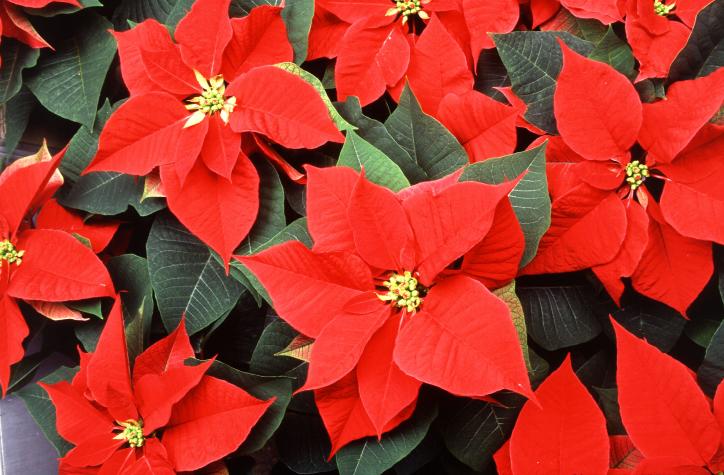COLUMBIA, Mo. – Poinsettia is our nation’s most popular potted flowering plant. What makes this remarkable is that most poinsettias are sold between the week of Thanksgiving and Christmas Day.
Despite its short sales period, poinsettia contributed $170 million to the U.S. economy last year, said University of Missouri Extension horticulturist David Trinklein. Native to southern Mexico and Central America, poinsettia has become symbolic of the holiday season for many Americans.
Poinsettia biology
Poinsettia is a short-day plant, meaning it needs long periods of uninterrupted darkness each day in order to bloom. In nature, the lengthening nights of late September and October trigger poinsettias to flower, Trinklein said.
The colorful part of the poinsettia that we enjoy isn’t a flower. What look like petals are specialized leaves called bracts. The true flowers, called cyathia, are the small structures in the center of the bracts.
While poinsettias with red bracts remain the most popular, they also come in creamy white, shades of pink and orange, marbled in pink and white, and with pink flecks on red. Many new poinsettia colors are not the result of plant breeding. “Bract color in poinsettia mutates very easily,” Trinklein said. “Different colors are the result of chance mutations from the original red.”
Choosing a poinsettia
When shopping for a poinsettia, look for leaves and bracts that do not show any wilting, which could indicate root problems, Trinklein said. Also, look at the underside of the leaves to check for insect damage.
Take a close look at the cyathia as well. “The presence of the true flower indicates the plant is still relatively young,” he said. When the cyathia are missing, the plant is likely past its prime.
Poinsettia care
With proper care, poinsettias stay beautiful throughout the holiday season. Put the plant in bright, indirect light, and do not overwater, Trinklein said.
“Poinsettias, just like most members of the Euphorbiaceae plant family, do not like wet soil,” he said. “If the plant sits on a saucer, empty it after the pot drains following watering.” Water left sitting in a saucer can wick up into the root zone and keep it overly wet. If your poinsettia is wrapped in decorative foil, make sure there is a drain hole in the foil.
It’s relatively easy to tell when a poinsettia needs water, Trinklein said. Pick up the pot. If it feels light, it may need water. Then touch the surface of the soil. If the soil feels clammy or moist, wait before adding more water.
You can skip fertilizer or plant food, Trinklein said. At the time of sale, the plant’s growth period is over, so its need for nutrients is minimal.
Poinsettias are not poisonous. Research conducted decades ago at Ohio State University debunked that urban legend, which still circulates today.
Photo available for this release:
Poinsettia
The poinsettia's small flowers are surrounded by colorful leaves called bracts. Photo by Scott Bauer, USDA Agricultural Research Service.
